Lincoln is situated between two very large wilderness areas, and is home to many wild creatures. Black bear, whitetail deer and moose draw hunters from all over. The moose have their own page here. We also have foxes, coyotes, bobcats, lynx, snowshoe hare, skunks, woodchucks, raccoons, pine martens, fishers, otters, beavers, porcupines, red, gray and flying squirrels, chipmunks, turtles and on and on and on.
There are plenty of bird species here also. Bald eagles, loons, wild turkeys, ducks, cardinals, orioles, chickadees and many, many more can be seen here.
We do have snakes, but ours are relatively small and none are poisonous. In fact, most of our wildlife isn't harmful to humans if you use a little common sense.
Bears are common, but not often seen. They are not usually dangerous unless you feed them or get between a mother and her cubs.
There are rumors of cougars being seen and heard in the Lincoln area, but none of the sightings has been officially verified as yet.
To see some drawings of local wildlife species, click here.
And then there are the Maine Tree Squeaks, but they're another story entirely. To find out more about these mischievous little creatures, click here.
|
|
|
|
This is a common merganser, a fish-eating duck. Several species of ducks can be found in the greater Lincoln area. |
|
Now here's something you don't see every day, although they're plentiful and make quite a racket in the spring. This little frog was photographed by Brad Blake in his patio garden. The tiny creature measures an inch or less. It's a spring peeper! Now you know what they look like. If you have really sharp eyes, you might see one among the leaves on the forest floor or in a tree. It's not often that you'll find one sitting on a bright green leaf like this!
|
|
|

Is this a lobster, or are Lincoln crayfish really this big? We'll never tell . . . .
|

Lincoln's "town ducks" are feral Mallards that stay here all year. You can see them at the lake intown, but please don't feed them. No matter what they tell you, they get plenty of food already!
|
|
|

A chipmunk fills its cheeks with goodies.
|
This young moose is having a snack near the road. Please watch the sides of the road for animals that might decide to cross in front of you.
|
We hope you enjoy our wildlife. If you go hunting or fishing, please follow the rules.
Whitetail deer are common in the Lincoln area. Deer hunting is allowed as follows: bow hunting in October, regular firearms in November and black powder hunting for a couple of weeks in December. Hunting licenses and current regulations are available at Lincoln's town office.
|
|
|
|
|
|
|
|
|
A painted turtle (left) was found crossing Penobscot Valley Avenue and transferred to a safer location. The snapping turtle on the right was laying her eggs in the sand at the edge of a road.
|

Bald eagles are not hard to find in Lincoln. This one lives just a few miles from downtown. We've even seen eagles flying right over the middle of town.
|
|
|
We took this video from a distance with a zoom lens. Please don't get too close to an eagle's nest. Depending on your Internet connection, the video may take a little while to load. Watch for an eagle chick flapping its wings, then one of the parents lands in the nest with a meal. We couldn't be sure, but we think there are two chicks in the nest.
You should click on over to the Squeak page soon, because they're waiting for you to visit them!
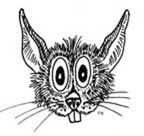
|

A great blue heron waits patiently for its lunch.
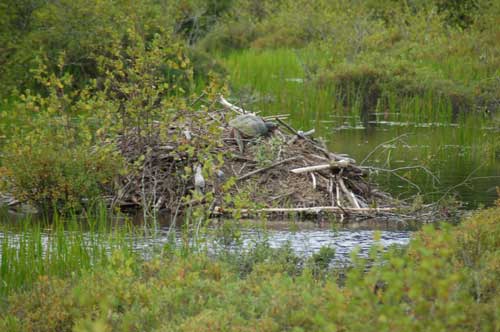
Sometimes you get more than you bargain for. Our photographer snapped a photo of a beaver's house, not realizing that the beavers had a visitor on their roof. When looking at the digital shot on his computer screen, he could see an enormous snapping turtle sunning itself! Click on the photo for a larger view.
|
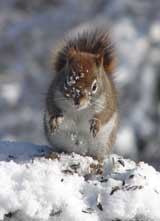
A red squirrel stuffing his face with birdseed.
|
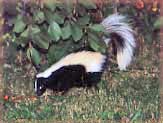
And here's someone you should leave alone. He's cute, but he could really mess up your day! On the plus side, he likes to eat slugs, and that makes our garden happy.
|
Beavers built a dam by this culvert, making a small pond. You can see their house in the background.
|

Wild turkeys are making a comeback in the Lincoln area. They can often be seen along roadsides or in fields around here.
|
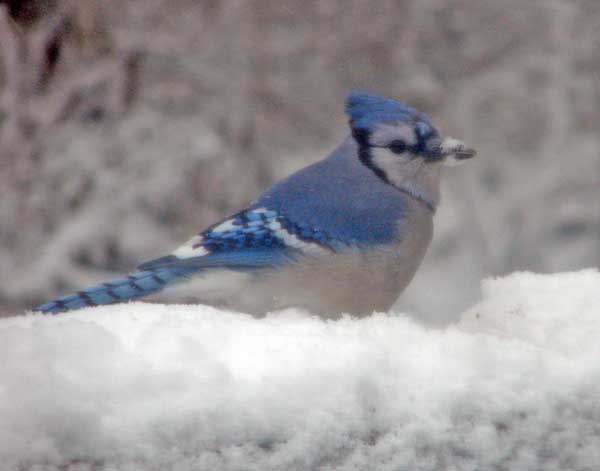
This bluejay stopped at our house to enjoy Thanksgiving dinner with a few of his friends.
|

A line of Canada geese with a few seagulls mixed in cast their reflections on the ice at Prince Thomas Park in downtown Lincoln.
|
|
|

This fat fellow showed up outside our office to help himself to some birdseed. We suspect he's the reason our feeder broke!
|
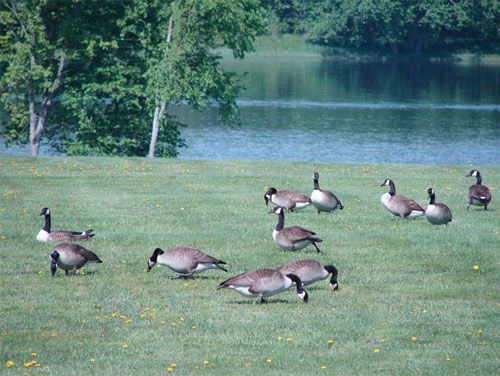
We found this flock of Canada geese enjoying a nice green grass lunch by the river. There's always at least one goose standing watch while the others eat.
|
Here's another big snapping turtle, looking to cross the road after laying her eggs. We would have liked to help her to the other side of the road, but decided she might misunderstand our motives and bite us! If you notice a snapper sunning itself on a log or crossing the road, leave it alone. They're faster than you think they are. They won't bother you if you don't bother them.
|
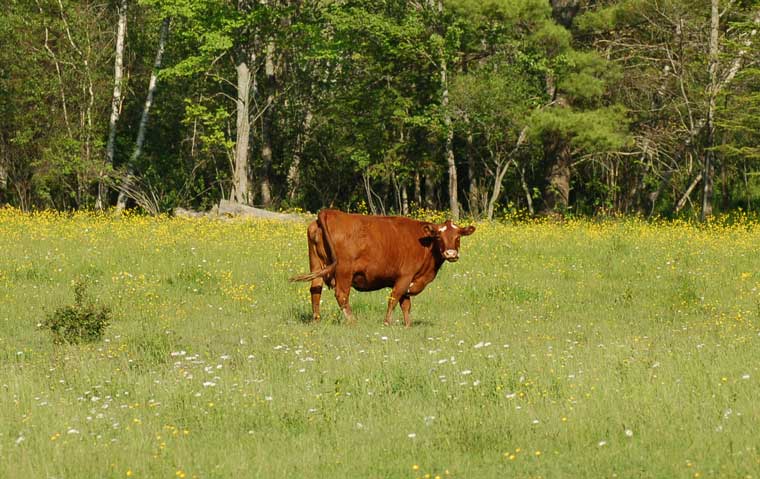
Wait a minute! What's she doing on the wildlife page? We just wanted to see if you were paying attention . . . .
|

Here's a hairy woodpecker having lunch in our back yard.
|
This cormorant was fishing at the lake downtown when we snapped his picture.
|
|
Believe it or not, Lincoln has a growing population of herring gulls (Larus argentatus). Also known as "dump ducks", herring gulls are common along the coast. To a gull, however, water is water whether it's fresh or salt. They eat absolutely anything that remotely resembles food. You might see them at the beach, begging along with the town ducks (don't feed them, please), or in any restaurant parking lot hoping someone will drop some scraps. Adult herring gulls are about 20 inches long, with a wingspan of around 55 inches.
|



